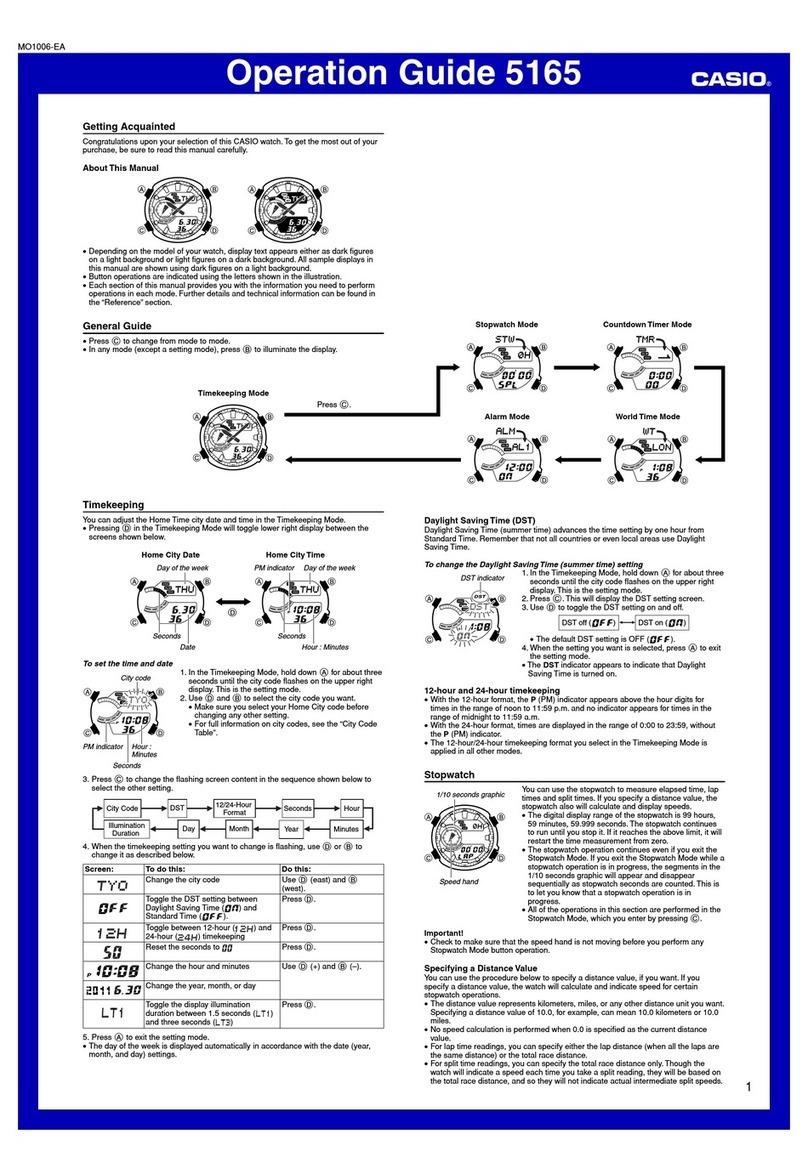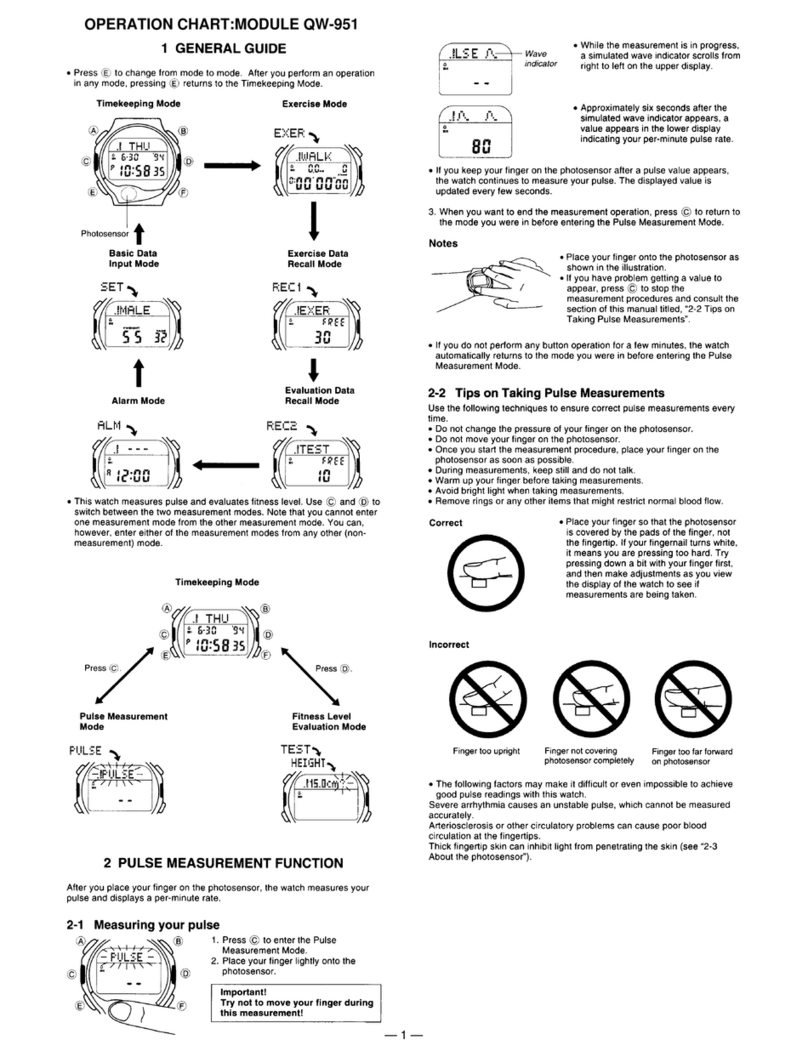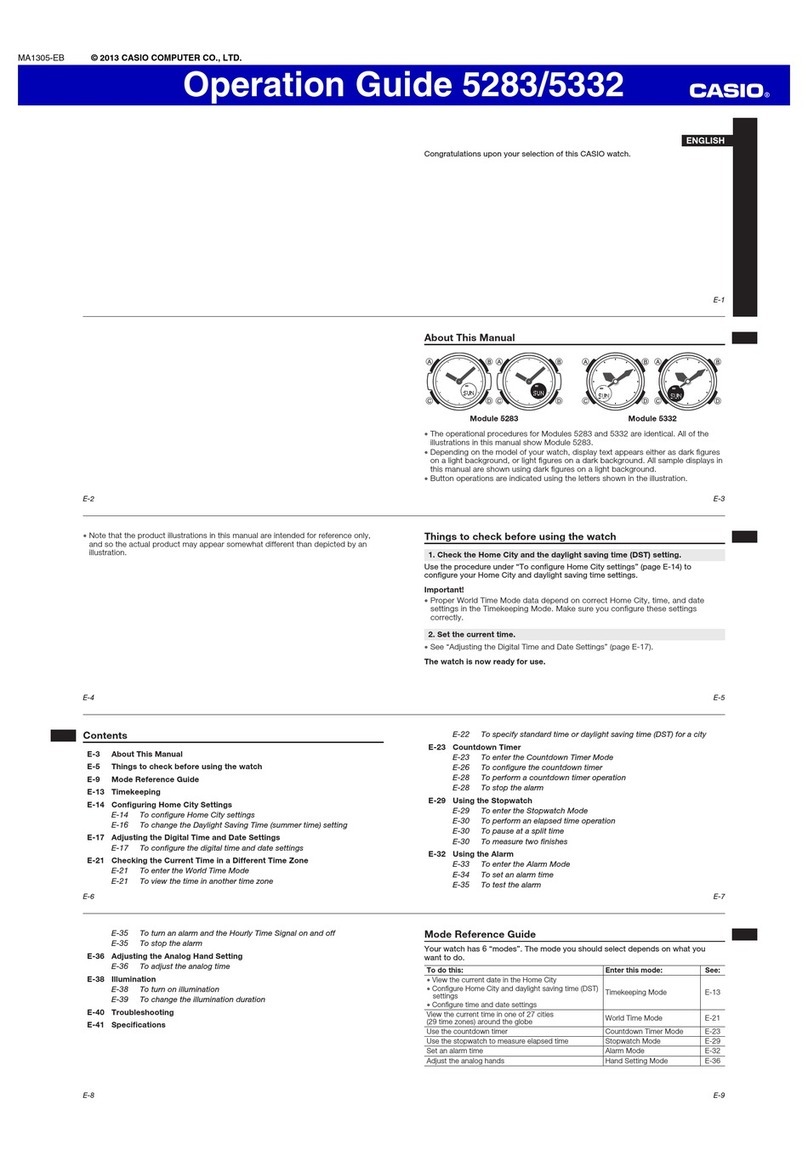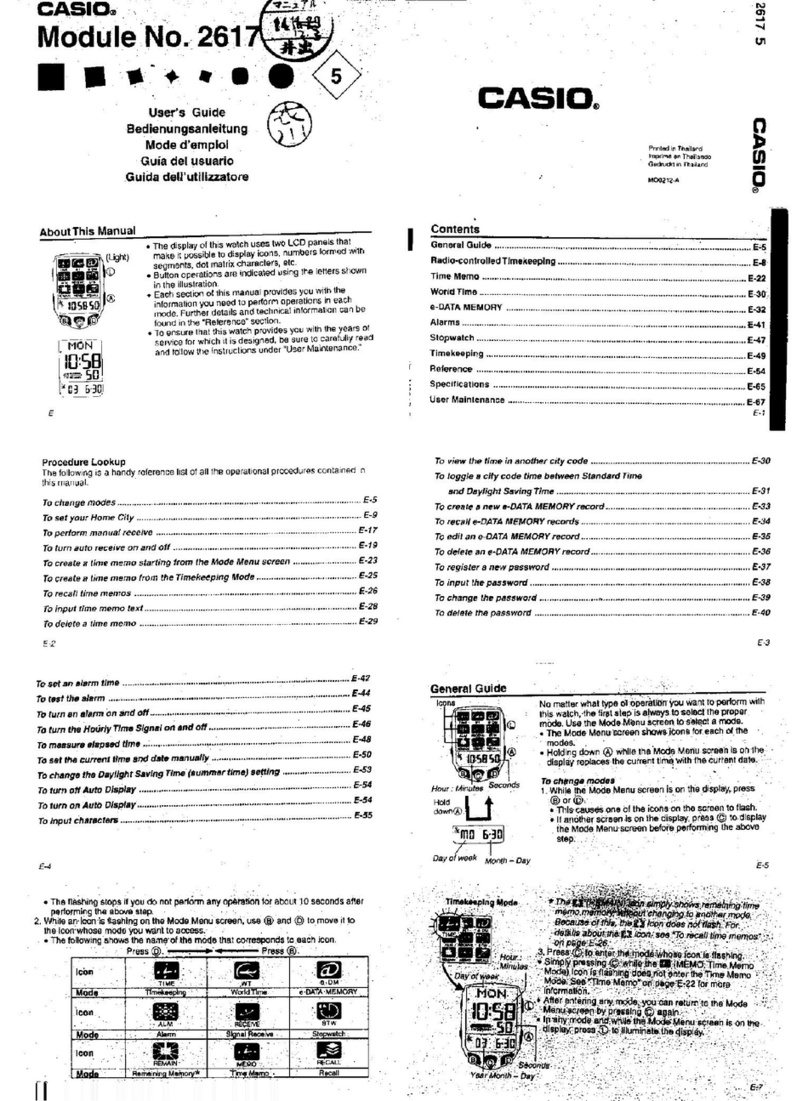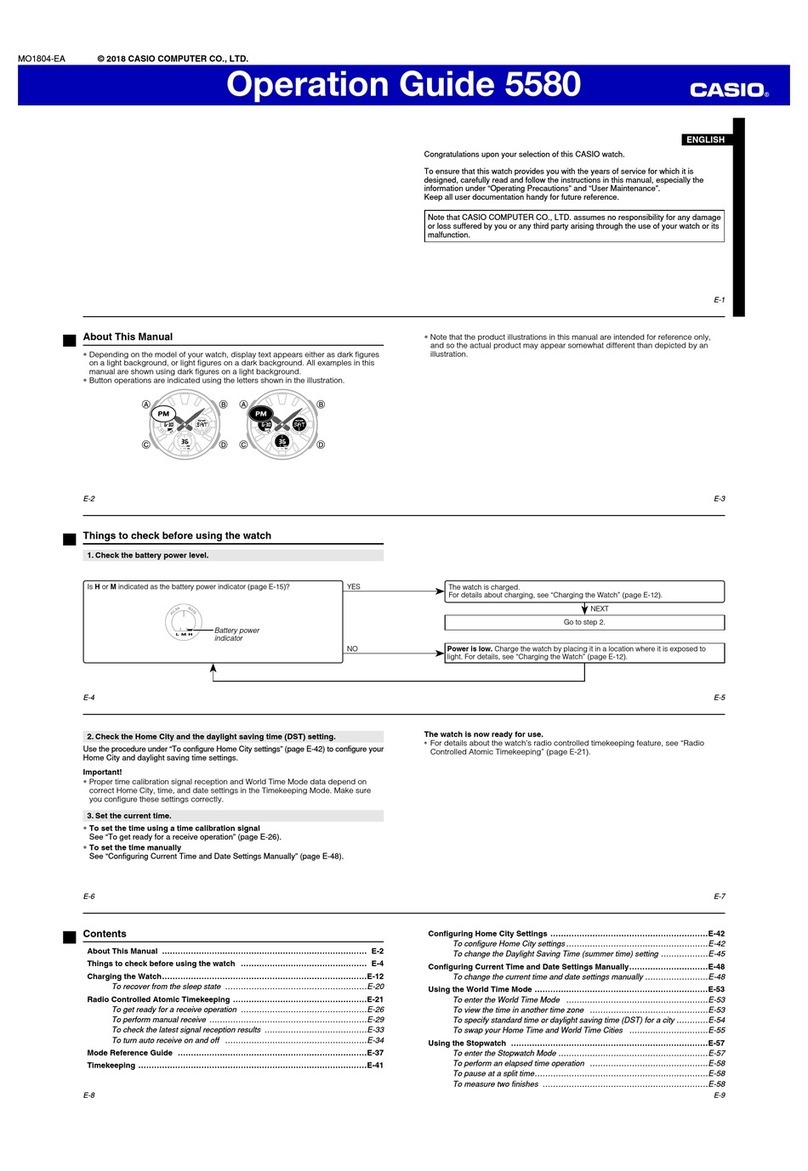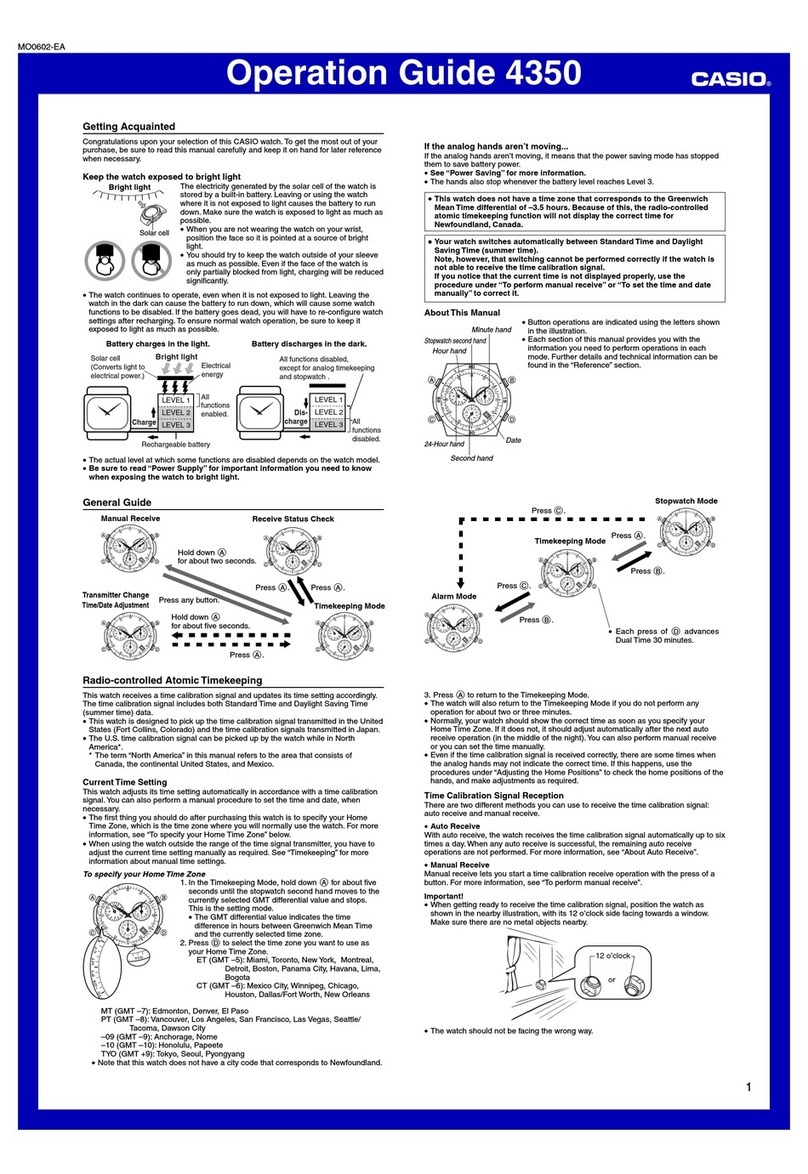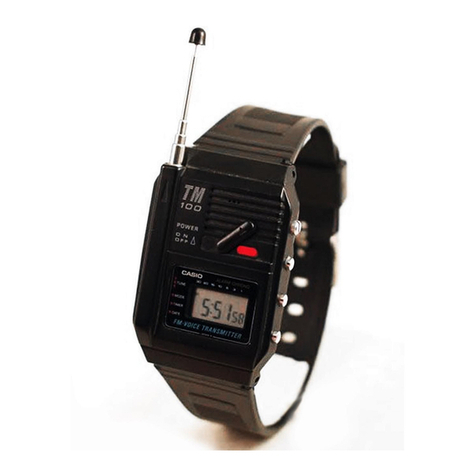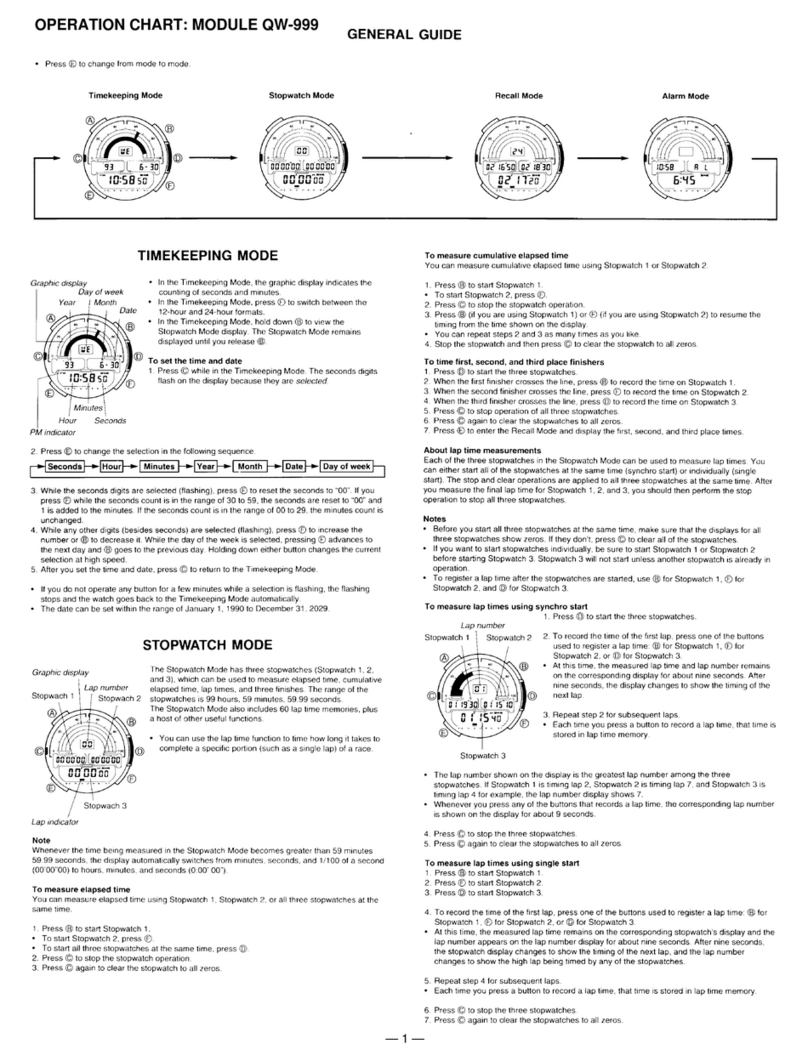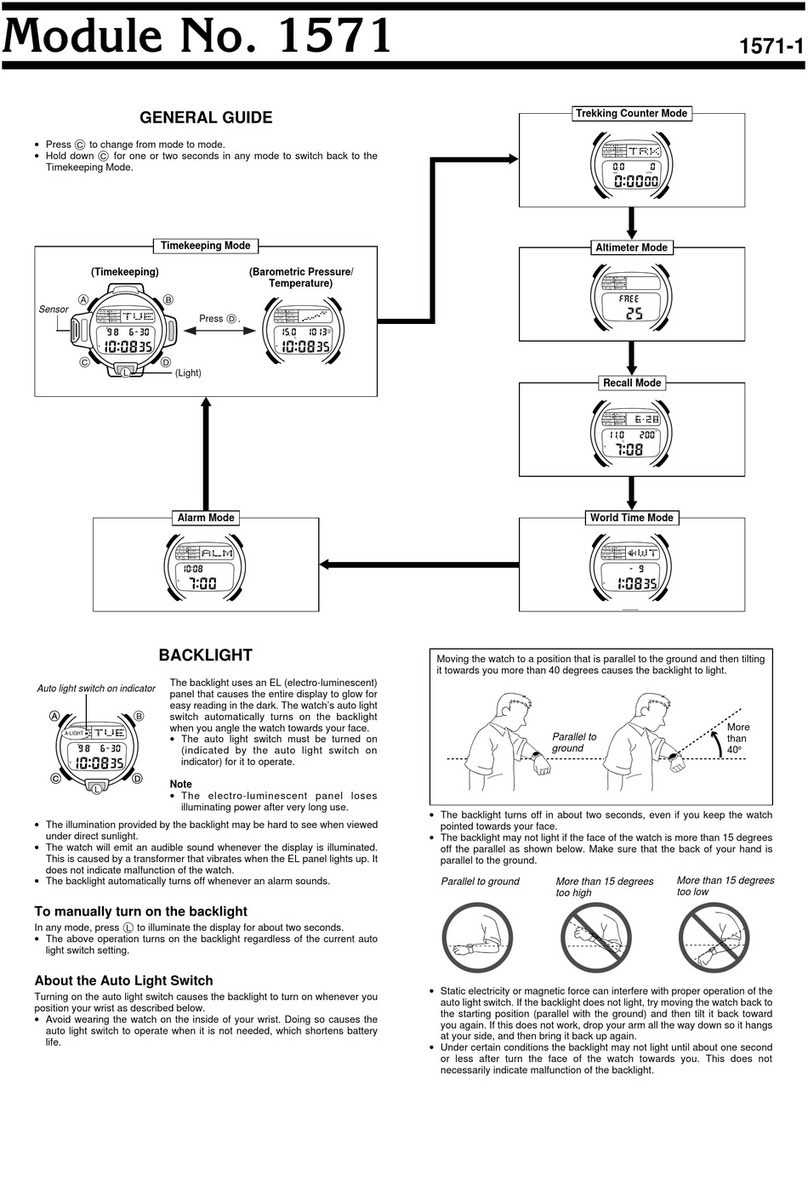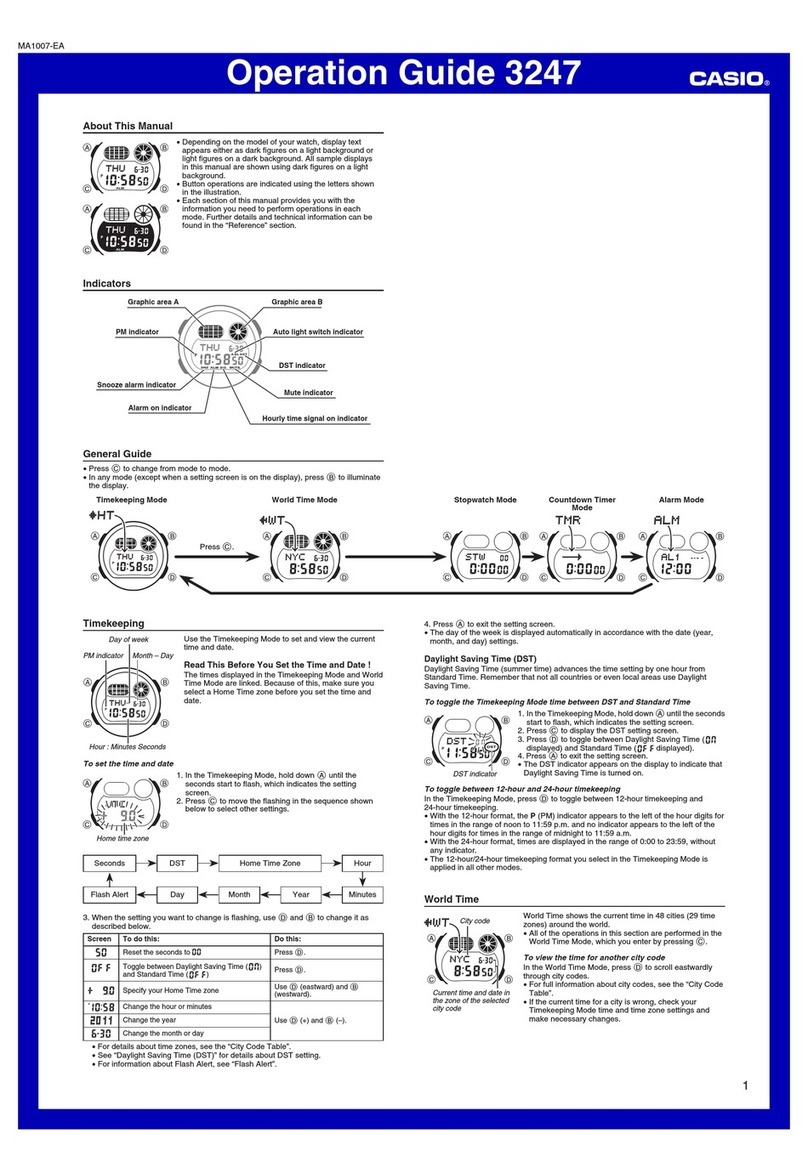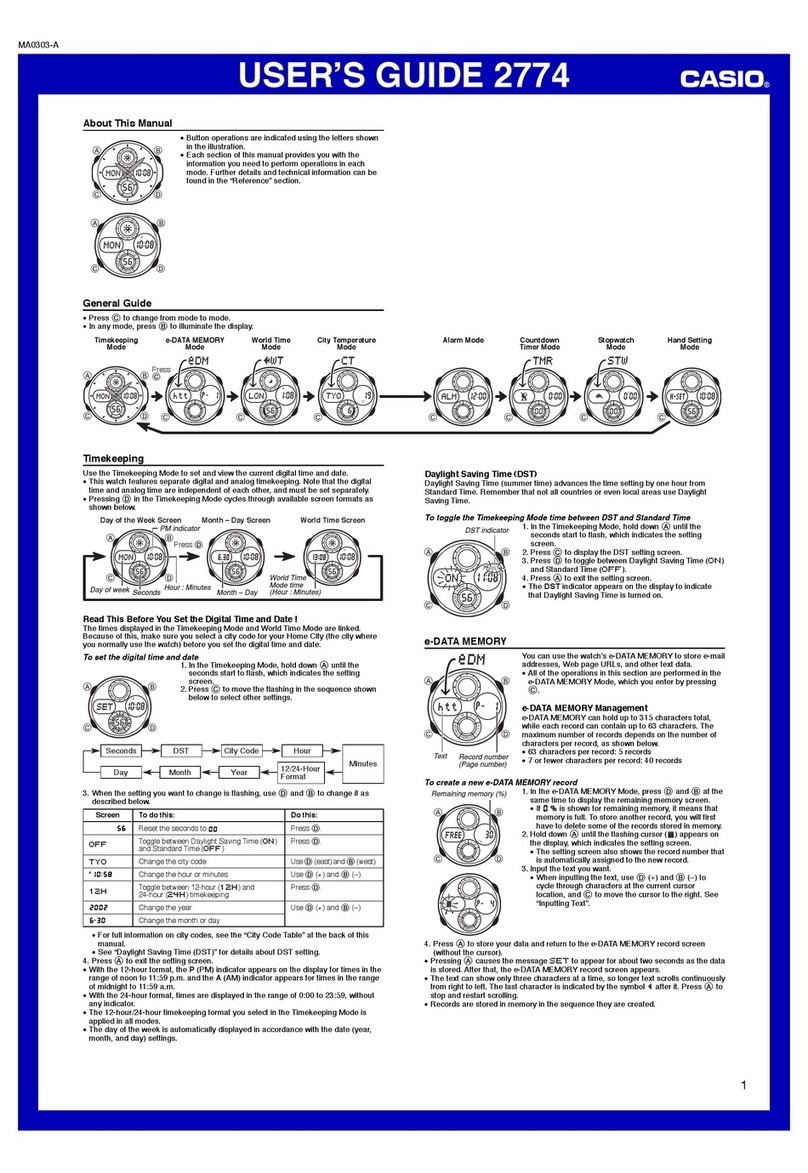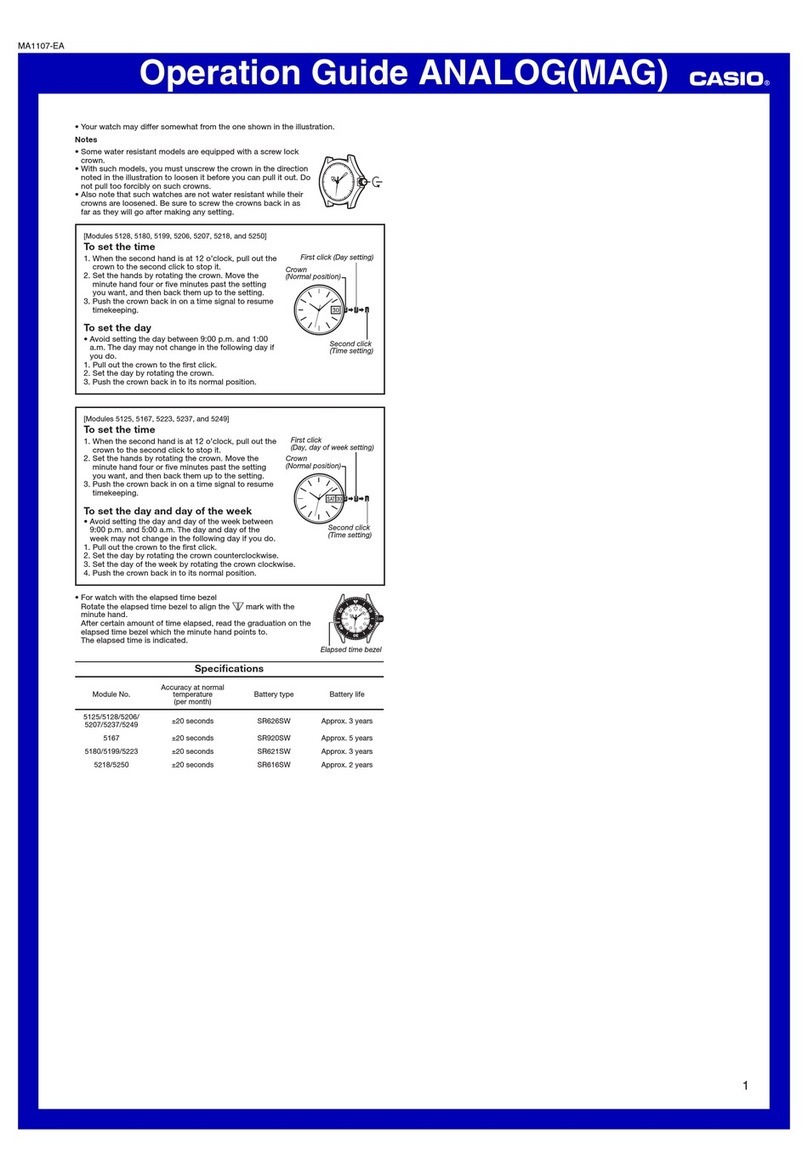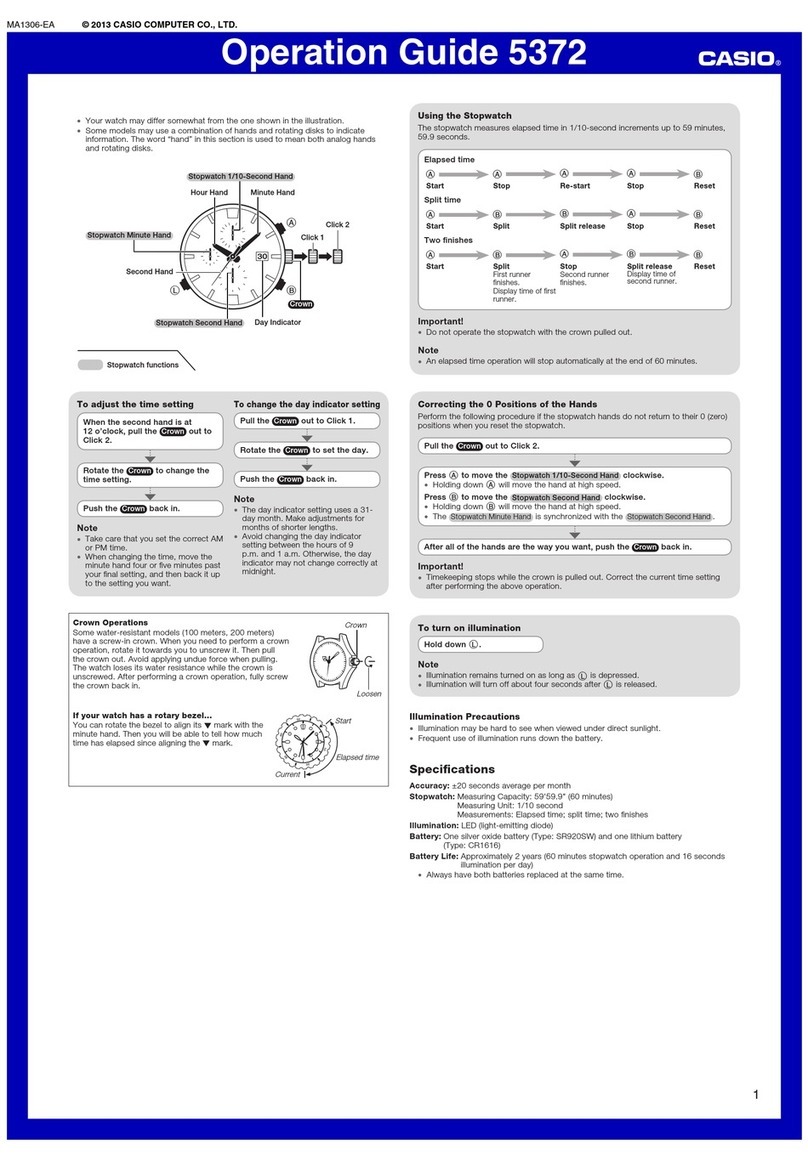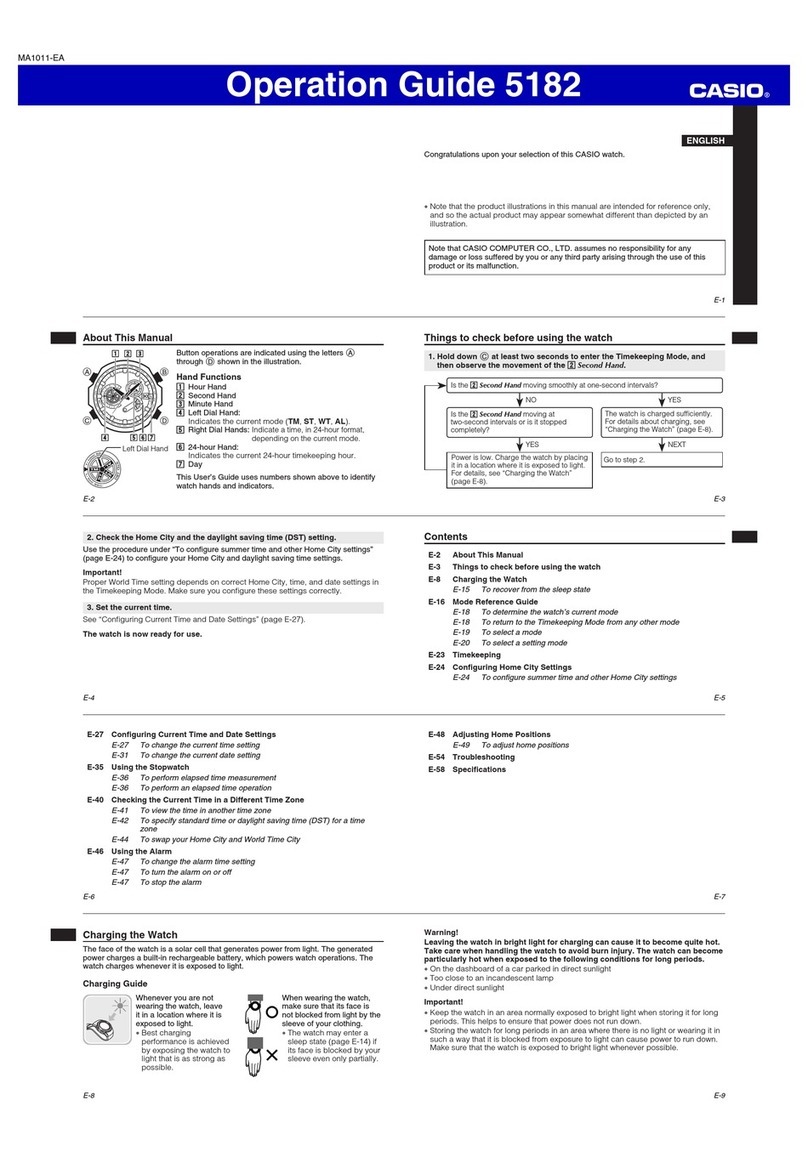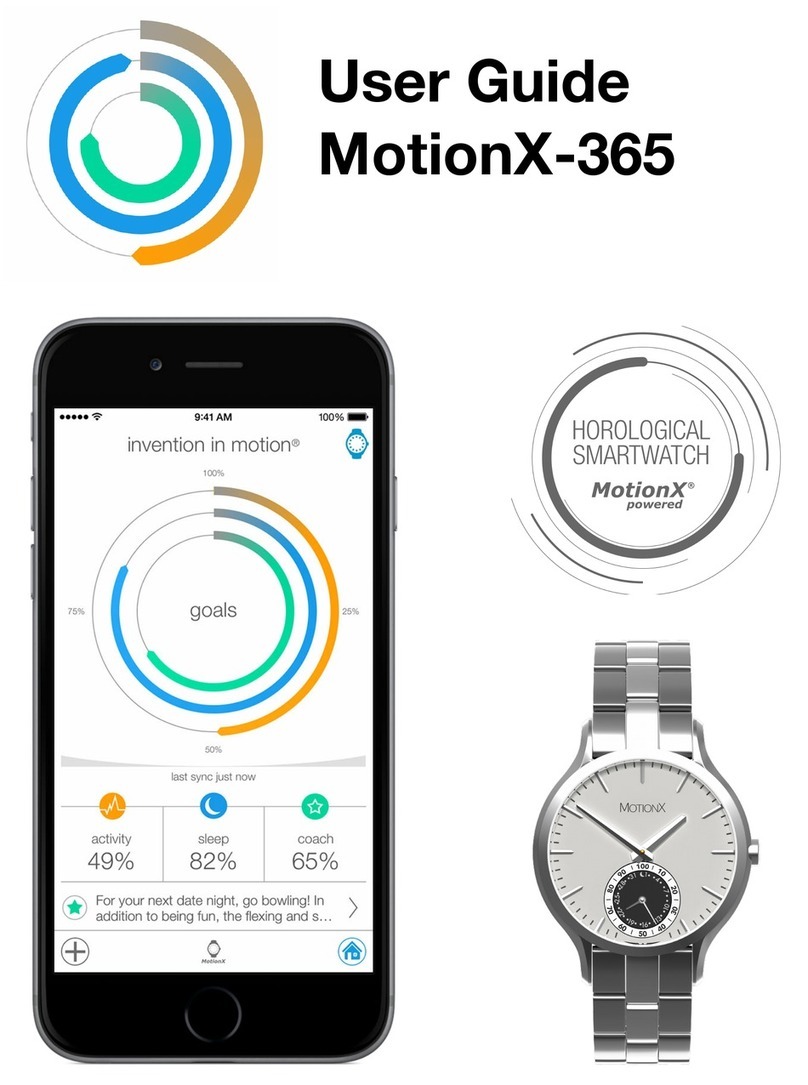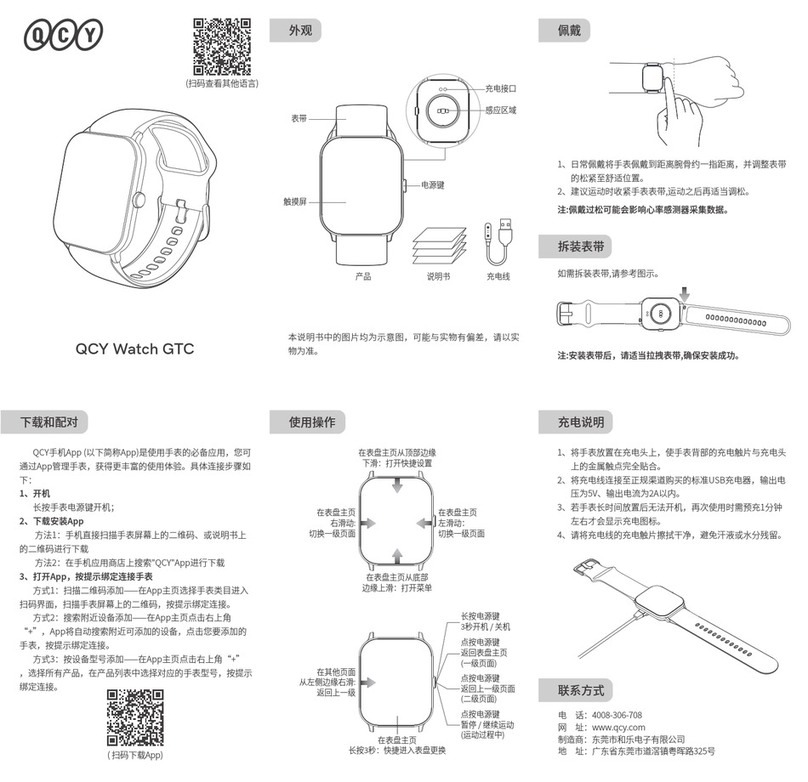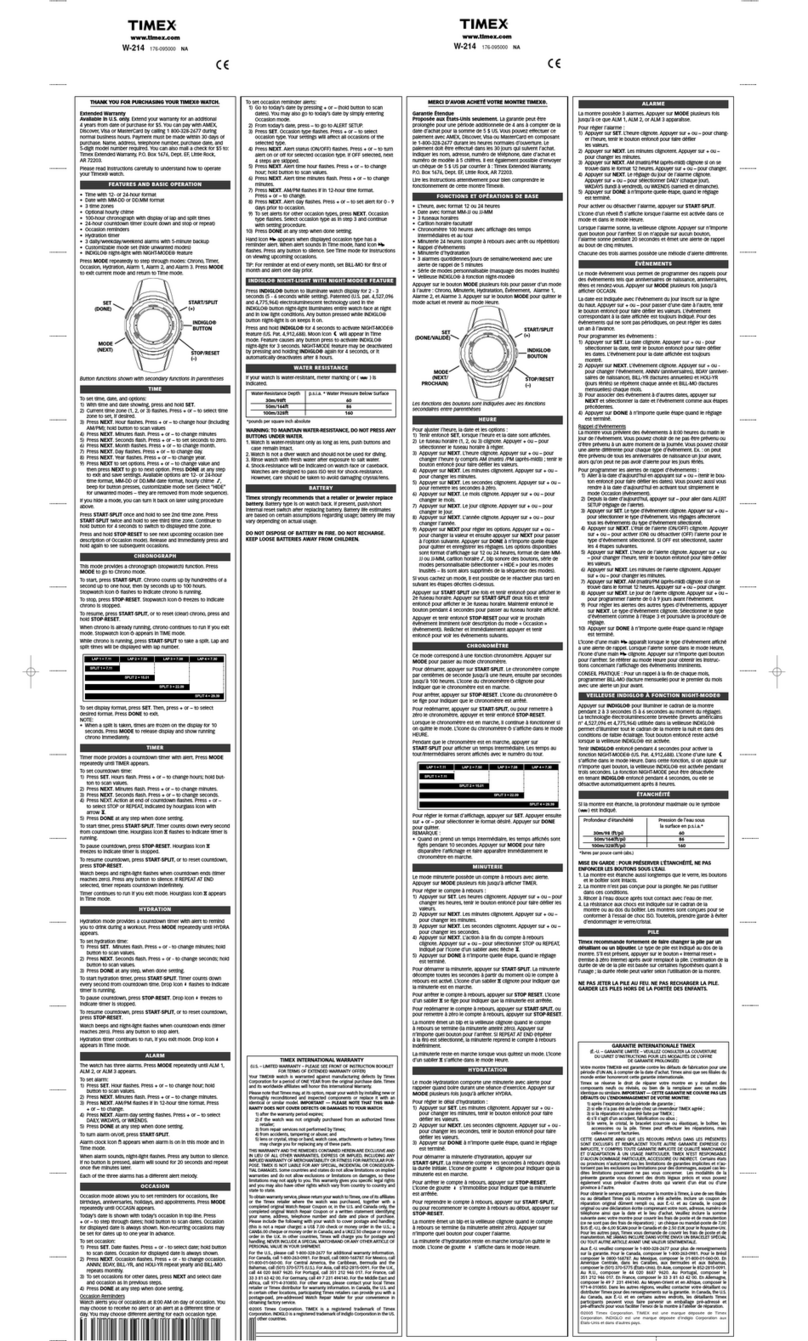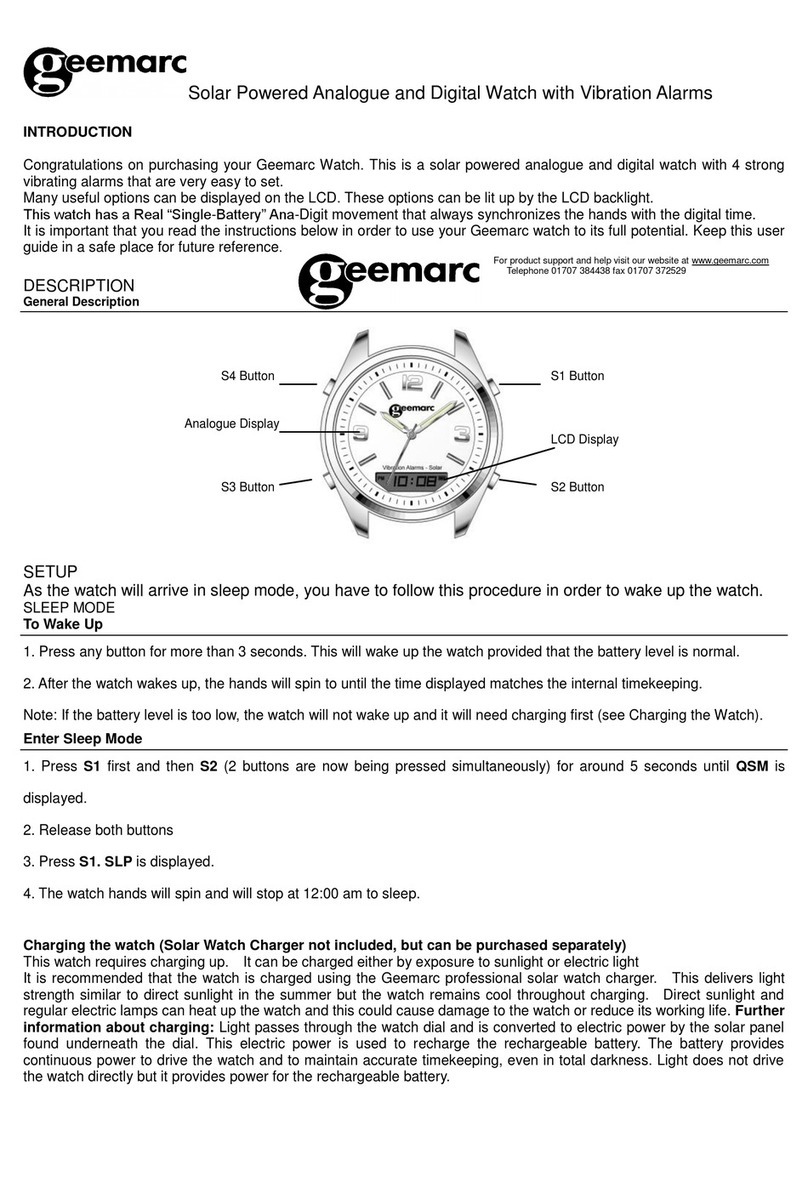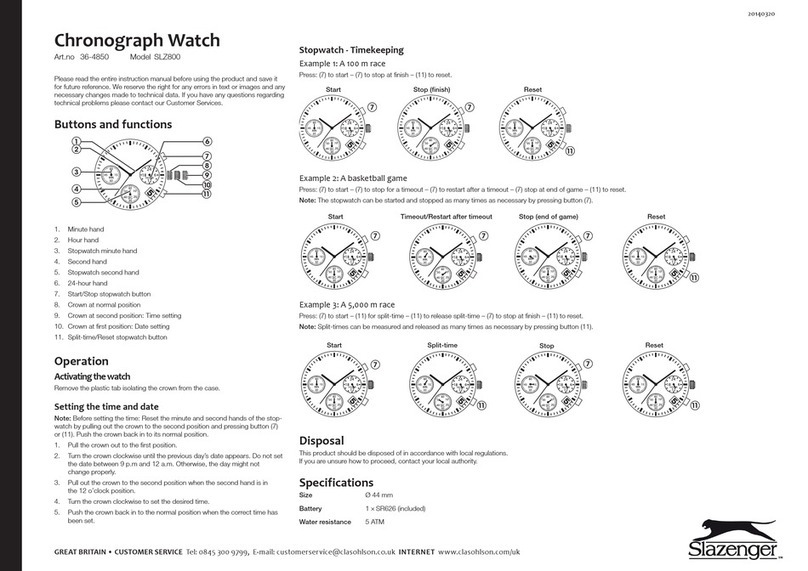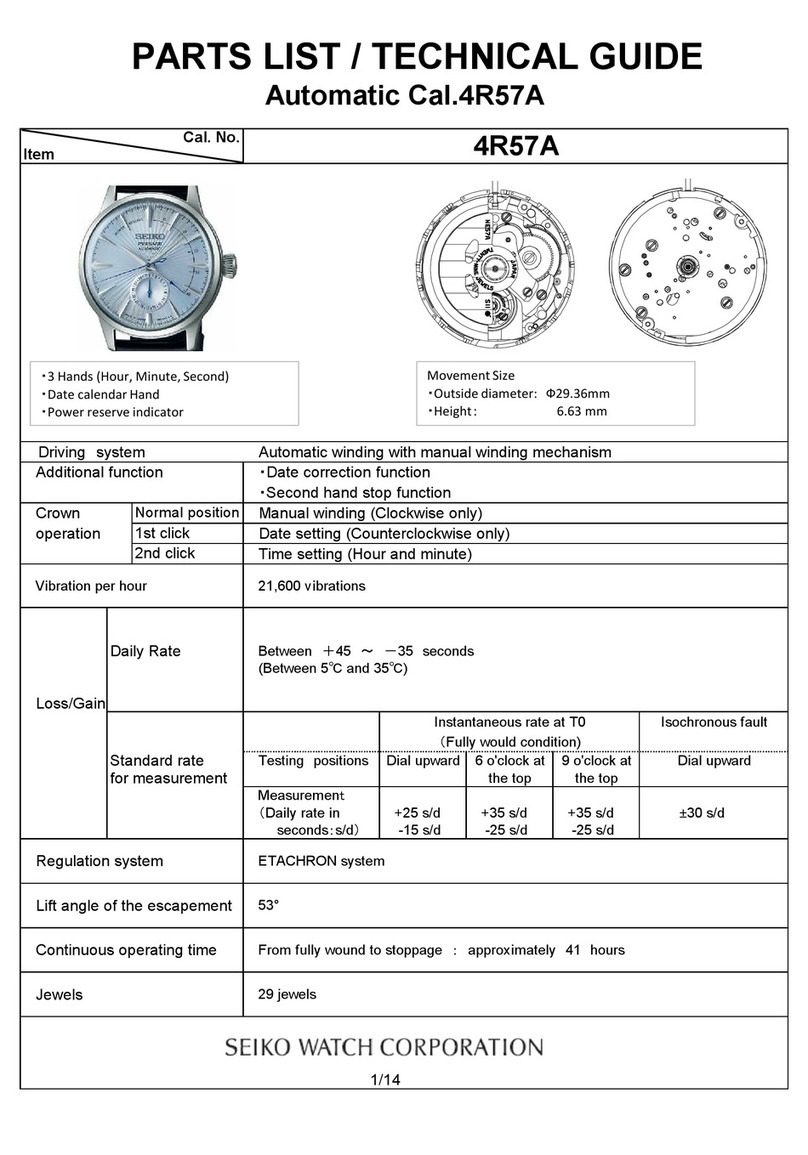
Operation Guide 5198
E-59
■ Auto Receive is not performed or I cannot perform Manual Receive.
Possible Cause Remedy Page
Your Home City setting is wrong. Check your Home City setting and correct
it, if necessary.
E-25
E-39
There is not enough power for signal
reception. Expose the watch to light to charge it. E-16
■ Signal reception is being performed successfully, but the time is wrong.
Possible Cause Remedy Page
Your Home City setting is wrong. Check your Home City setting and correct
it, if necessary.
E-25
E-39
The watch may have been exposed
to magnetism or strong impact, which
has caused problems with proper
hand alignment.
Adjust the watch’s hand home positions. E-48
E-58
■ The current time setting changes after I set it manually.
You may have the watch configured for Auto Receive of the time calibration signal
(page E-31), which will cause the time to be adjusted automatically according to your
currently selected Home City. If this results in the wrong time setting, check your
Home City setting and correct it, if necessary (page E-39).
■ The current time setting is off by one hour.
Possible Cause Remedy Page
Signal reception on a day for
switching between STD (standard
time)/DST (daylight saving time) may
have failed for some reason.
Perform the operation under “To get ready
for a receive operation”. The time setting
will be adjusted automatically as soon as
signal reception is successful.
E-30
If you are unable to receive the time
calibration signal, change the STD
(standard time)/DST (daylight saving time)
setting manually.
E-43
E-57
■ The
Second Hand indicates N (NO) when I check the result of the latest
receive operation.
Possible Cause Remedy Page
You are wearing or moving thex
watch, or performing a button
operation during the signal receive
operation.
The watch is in an area with poor
x
reception conditions.
Keep the watch in an area where reception
conditions are good while the signal receive
operation is being performed.
E-30
You are in an area where signal
reception is not possible for some
reason.
See “Approximate Reception Ranges”. E-27
The calibration signal is not being
transmitted for some reason.
Check the website of the organizationx
that maintains the time calibration signal
in your area for information about its
down times.
Try again later.x
—
E-56
Time Calibration Signal
The information in this section applies only when LONDON (LON), PARIS (PAR),
ATHENS (ATH), HONOLULU (HNL), ANCHORAGE (ANC), LOS ANGELES (LAX),
DENVER (DEN), CHICAGO (CHI), NEW YORK (NYC), HONG KONG (HKG), or
TOKYO (TYO) is selected as the Home City. You need to adjust the current time
manually when any other city is selected as the Home City.
E-55
■ The current time setting is off by one hour.
The standard time/daylight saving time setting is wrong. See “Standard Time and
Daylight Saving Time Settings” (page E-43).
Second hand position and Home City indication are not correct.■
This could indicate that the watch has been exposed to magnetism or strong impact,
which has caused problems with proper hand alignment. Adjust the watch’s hand
home position alignment (page E-49).
Charging
■ The watch does not resume operation after I expose it to light.
This can happen after the battery charge level drops to Level 4 (page E-18). Continue
exposing the watch to light until the
Second Hand starts moving normally (at one-
second intervals).
E-54
The watch is recovering from a sleep state (page E-24).x
The time setting is being adjusted following a successful auto time calibrationx
signal receive operation (page E-25).
Nothing happens when I rotate the crown.■
Leaving the crown pulled out for more than two minutes without performing any
operation will automatically cause the setting operation to become disabled. If this
happens, press the crown back in and then pull it out again to configure settings. See
“Crown Operations” (page E-6).
Hand movement is stopped.■
The watch may have been exposed to magnetism, which will cause the hands to
stop at their current positions. Pull the crown out to the first click or press a button
to restart hand movement. If the indicated time is not correct, perform home position
adjustment. See “Adjusting Home Positions Manually” (page E-49).
■ The current time setting is off by hours.
Your Home City setting may be wrong. Check your Home City setting and correct it, if
necessary (page E-39).
E-53
Troubleshooting
Hand Movement and Position
■ The
Second Hand is moving in the pattern:
1 second 1 second 2 seconds.
The battery charge is starting to go low. Expose the watch to light to charge it. See
“Charging the Watch” (page E-16).
■ The
Second Hand is moving at two-second intervals.
■ All of the watch’s hands are stopped at 12 o’clock, and the Abutton and
crown do not do anything.
The battery charge may be low. Expose the watch to light until the
Second Hand
starts moving normally, at one-second intervals (page E-18).
■ The hands of the watch suddenly start moving at high speed, even when I do
not perform any operation.
This could be due to any one of the following causes. In all cases, the hand movement
does not indicate malfunction, and should stop shortly.
E-52
Press8. A.
Thex
Hour Hand,
Minute Hand and
Second Hand should move to their
correct home positions (12 o’clock) when you release A. This can take up to
about 10 minutes.
Rotate the crown to adjust the positions of the hands.9.
A high-speed forward movement feature (12 hours maximum) and a high-speedx
backward movement feature (one hour maximum) are available when adjusting
the positions of the hands.
Crown Operations (page E-6)−
Push the crown back in.10.
This completes home position adjustment when hands are off within ±15 minutes
x
00 seconds, and returns to regular timekeeping. Note that it can take up to about
10 minutes before the watch returns to regular timekeeping.
Note
You can stop hand adjustment at any time by pushing the crown back in. This will
x
return to regular timekeeping with the hands at positions reflecting any changes
you made up to that point.
E-51
After everything is the way you want, push the crown back in.6.
This completes home position adjustment when hands are off within ±15 minutes
x
00 seconds, and returns to regular timekeeping. Note that it can take up to about
10 minutes before the watch returns to regular timekeeping.
Hands off by more than ±15 minutes 00 seconds
In this case, check the position of the
Home City Indicator first.
Press7. Aand check the
Home City Indicator.
The
x
Home City Indicator should show a star (★), and the
Second Hand
should move until it is aligned with the bottom of the
Home City Indicator.
Note that this will take about 90 seconds.
If the
x
Home City Indicator does not show a star (★), rotate the crown until it
does.
A high-speed movement feature (one full cycle maximum) is available when
adjusting the home position of the
Home City Indicator.
E-50
Hands off within ±15 minutes 00 seconds
Rotate the crown to move the4.
Second Hand and
Minute Hand to their correct
home positions (12 o’clock).
A high-speed movement feature (15 minutes maximum) available when adjusting
x
the home positions of the hands. See “Crown Operations” (page E-6).
Press5. Aand check the
Home City Indicator.
Thex
Home City Indicator should show a star (★), and the
Second Hand
should move until it is aligned with the bottom of the
Home City Indicator.
Note that this will take about 90 seconds.
If the
x
Home City Indicator does not show a star (★), rotate the crown until it
does.
A high-speed movement feature (one full cycle maximum) is available when
adjusting the home position of the
Home City Indicator. See “Crown
Operations” (page E-6).
